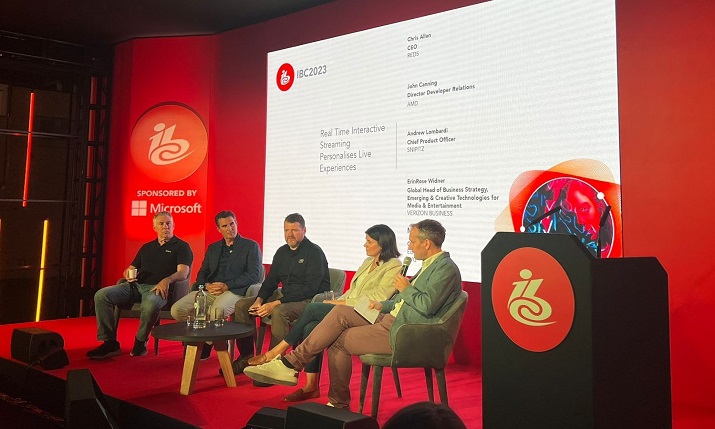IBC 2023: Real-time interactive streaming and the personalisation of live experiences
In the second of a four-part series, SVG Europe provides a roundup of the sport-focused IBC Accelerator discussions at IBC 2023. Next up, the ‘Real-Time Interactive Streaming Personalises Live Experiences’ Accelerator project.
Hosted by SVG Europe editorial director George Bevir, this fascinating panel discussion explored the IBC Accelerator, ‘Real Time Interactive Streaming Personalises Live Experiences’.

The Accelerator sought to demonstrate that additional revenue and ROI can be achieved through personalising viewer engagement from the streaming of live interactive experiences.
“Our aspiration for this project was to see if live real-time and interactive streaming could actually enhance the fan experience,” said Chris Allen, chief executive, Red5.
John Canning, director of developer relations for AMD said he has been “trying to do live fan engagement for 20 years”.
“There have been fits and starts in the past; we can technically do it, throw a lot of cameras up and capture a lot of it, but you actually have to find a customer,” he added. “You have to broadcast that or transmit it and you have to have an endpoint that can support that. You have to find the end-to-end solution, that all has to come together.”
The solution that the Accelerator came up with was a real-time interactive experience of a tennis game running on the game engine Unity with an overlay from Singular.Live. Using Verizon 5G, fans on mobile devices could select from multiple angles and player perspectives, switching views with ultra-low latency.
Andrew Lombardi, chief product officer for Snipitz, said that if you do that in real time on phones used by fans in the stands, there are options for monetisation. “The person at home is seeing it at the same time as the person watching it live,” said Lombardi. “So now you can start introducing interactivity ads, gamification, and betting overlays that can give the content owners a new revenue stream.”
Lombardi said the project turned to Unity “because we were trying to figure out how would you do 50,000 concurrent users getting six streams in real time and they’re all interacting in different ways.”
The panel:
- Chris Allen, CEO, Red5
- Andrew Lombardi, Chief Product Officer, Snipitz
- ErinRose Widner, Global Head, Business Strategy Emerging & Creative Technologies | Media & Entertainment, Verizon Business Group
- John Canning, Director of Developer Relations, AMD
- George Bevir, Editorial Director, SVG Europe (host)
Accelerator Champions: Verizon Business, The LoLpga (Legends of the LPGA)
Accelerator Participants: Red5Pro, Snipitz, AMD, Osprey, and Singular.live.
The game engine has the ability for mixed media modes, and to allow interfaces to be built on it, said Canning. “You’re looking at an engine that is designed to work in mobile environments, they’ve solved that problem,” he added. “We’re just plumbing it to do this live video, but that’s where we see the utility of these engines, going beyond the game so to speak.”
ErinRose Widner, global head, Business Strategy Emerging & Creative Technologies, Media & Entertainment, for Verizon Business Group, gave an overview of the Champions behind the Accelerator, and what Verizon’s interest was.
“This does democratise the sports that are available and how you’re watching it,” she said.
“By offering those new experiences and seeing how the audiences at home and the venues like to play with their content, gives [broadcasters] the analytics and data that they can see how the live event performed, and they can change their live event.”
Lombardi added: “The content owners have all this information of the single user journey, not the typical video analytics about how many people watched it, and for how long.
“[They know] what that single person did during your entire live event, what court they watched, what angle they watched. Did they bet? Did they interact with surveys? Now you have the information on that one person, you can serve them a personalised experience next time.”
Canning raised the question of audio. “We’ve talked about the viewing experience, but the key to this kind of solution is seamless audio,” he said. “If you’re sitting there and when you switch to a view and the audio isn’t synced properly, it disrupts the experiment.”
Canning said that while new technology increased the flexibility of the transmission and the endpoints, the rights issues were still a problem.
With rights still in mind, Bevir quizzed the panel on how to roll the project out into the real world, to which Widner suggested that the vendors targeted the teams and leagues that haven’t yet been signed up by the big US broadcast networks.
Allen said that to a certain extent, this might level the playing field: “The big leagues obviously have budgets for R&D, but the smaller leagues don’t have that ability. I think Snipitz bringing it in a packaged way to them is key.”
Read more Connect and Produce Anywhere: Discussing the future of live production at IBC 2023
The panel discussed the next generation of coverage, including XR, multilingual audio, regened legacy content and personalisation of sports betting and targeted/integrated advertising. Widner brought up the challenge of appealing to the next generation of viewers and the likelihood of AI predicting what a viewer will want and personally tailoring that experience.
“It’s changing the face of sport, and I think as we move into the future, we’ll want to consume our content, much more tailored to ourselves,” she said. At Verizon, we were particularly excited about this project because we are very invested in that fan experience, which I think is the future of entertainment and media.”

